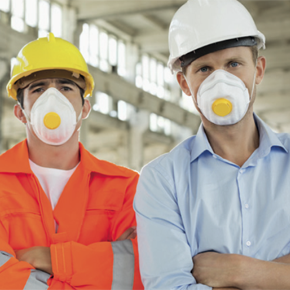
How to create a healthy environment for construction workers
The construction industry has a poor health record. Each year in this sector, 3% of site personnel suffer from an illness they believe to be work-related. This number equates to 1.7 million working days lost every year to ill-health.
And whilst there have been big improvements in health and safety standards over the years, construction remains a high risk industry.
What are the main health-associated risks that constructions workers face?
1. Cancer
The HSE state that “construction accounts for over 40% of occupational cancer deaths and cancer registrations.” With an estimated annual figure of 5,000 cases, approximately 3,700 of those result in death.
Asbestos is the Number One cause. Silica takes the Number Two spot. And painting and diesel fumes are Number Three.
2. Disease
Hazardous substances such as dust and chemicals are the cause of many serious diseases and chronic conditions that workers face.
Standard construction processes that release dust, fumes, vapors or gases into the air can cause irreparable damage to the lungs, brain, eyes and skin. More information about health hazards of dust inhaling can be found in this Dust Control Whitepaper.
And chronic conditions such as, dermatitis is on the rise with cases multiplying each year from not wearing the correct protective equipment.
3. Physical issues
Unsurprisingly back injury is common among construction workers, with the amount of manual labour involved and the lack of site checks to ensure that proper equipment and lifting processes are in place.
But perhaps surprisingly, construction has one of the highest rates of ill health caused by machinery noise and vibration.
So how can companies create a healthy environment for their construction workers and contractors?
1. It is important to remember that everyone has a role to play.
- From, the client commissioning the work to the contractors, small builders and individual workers. It’s everyone’s responsibility, by Law.
- Pay attention to your environment and if something isn’t right, flag it, immediately.
2. Carry out regular site assessments.
There are four phases when doing this:
1 – Planning phase
What size is the site? Where is it? How many different contractors will be on site? Who has over-arching responsibility and how will this be managed?
2 – Identify the health hazards
What tasks will you or the worker be carrying out? Where will those tasks take place? What risks could be associated with each of those tasks? Will other people be affected by any of those tasks? If so, what could the risk be?
3 – Assess the risk
With each risk, assess the significance of it. How many people would be involved, the location and the likely outcome of damage?
4 – Involve personnel
Inform all site personnel of the risks associated with that specific site and job. Ask them to discuss preventative measures and to offer their ideas for reducing the risk to site personnel. This collaboration creates a team-like culture regardless of the number of different contractors and sub-contractors there are on site.
3. Control the risks.
Once the risks have been identified, find ways to prevent or minimize them.
What solutions are there to reduce harmful substances from permeating the air? Is there adequate ventilation? Has the correct ventilation solutions & systems been provided? Is it tested and up-to-date?
And finally, ensure all site personnel are fully trained.
4. Continually monitor and review potential risks.
Don’t stop after the initial assessment and strategy. This is an ongoing process that should be monitored, reviewed and changed as needed to ensure the health and wellbeing of all site personnel.
- To reduce the number of site-related illnesses.
- To reduce the number of injuries and fatalities.
It’s everyone’s responsibility.
Create a healthy environment for your site personnel today.
References:
1. Illness prevalence, Labour Force Survey annual average 2011/12, 2013/14, 2014/15
Author Bio:
Tim Dupont is a Marketing Director at RVT Group and has been with the company since 2007. Since joining the company Tim has been very involved with the sales department and for the last two years he has been spearheading the marketing department including the brand progression. Tim is experiencing a very exciting move forward and is very pleased to be part of a great team at RVT Group.
Latest news

22nd November 2024
Insight Data: Using Marketing Data to Build a Successful Business in 2025
Alex Tremlett, Insight Data’s Commercial Director, discusses the challenges for construction firms in 2025 and shares six strategies for success…
Posted in Articles, Building Industry News, Building Services, Information Technology, news, Research & Materials Testing
22nd November 2024
Purplex: A tough Budget, but opportunity still knocks
Incoming governments, especially those with significant mandates, inevitably come into power on a tidal wave of optimism coupled with hope that ‘Things can only get better’. Andrew Scott, MD of construction-focused, full-service agency Purplex, talks…
Posted in Articles, Building Industry News, Building Services, Information Technology, news, Posts, Research & Materials Testing
22nd November 2024
Pop Up Power Supplies Gets Arty in Yorkshire
Pop Up Power Supplies has installed 13 new electricity units at The Hepworth Wakefield – read more in this article…
Posted in Articles, Building Industry News, Building Products & Structures, Building Services, Case Studies, Civil Engineering, Facility Management & Building Services, Garden, Hard Landscaping & Walkways, Landscaping, Posts, Restoration & Refurbishment, Retrofit & Renovation
22nd November 2024
OPT Services Revolutionises Fibre Cable Capping with Eco-Friendly Innovation
UK-based OPT Services has unveiled SlimLine™ Capping, a groundbreaking fibre cable protection solution that promises to deliver significant environmental and installation advantages to the fibre optic industry.
Posted in Articles, Building Industry News, Building Products & Structures, Building Services, Facility Management & Building Services, Information Technology, Innovations & New Products, Sustainability & Energy Efficiency
 Sign up:
Sign up: